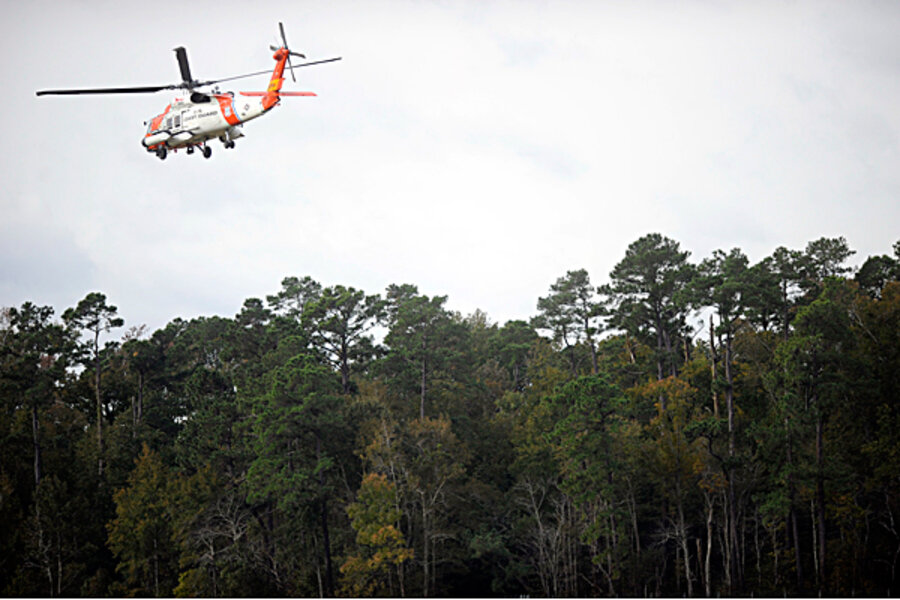Many questions, few answers about loss of HMS Bounty to hurricane Sandy
The US Coast Guard continued Thursday to search for Robin Walbridge, one of two sailors lost when the 180-foot HMS Bounty, a 1960 replica of a famous 18th-century merchant vessel, foundered and sank in the throes of hurricane Sandy on Monday.
But as the search enters its fourth day, persistent questions arise about why the captain put a small, mostly greenhorn crew into the treacherous waters off Cape Hatteras, N.C., within reach of a hurricane.
To be sure, Captain Walbridge had sailed the Bounty for about 17 years and was, in his wife’s words, “the best in the industry” – that industry being educational missions of modern tall ships.
In a post to Facebook before the ship ran into trouble, Walbridge defended what apparently was a controversial decision to cast off from Connecticut ahead of the storm. "Bounty's current voyage is a calculated decision... NOT AT ALL... irresponsible or with a lack of foresight as some have suggested. ... A SHIP IS SAFER AT SEA THAN IN PORT!” Walbridge wrote.
The Bounty’s 14 survivors have collectively decided to not speak to the press out of respect for Walbridge and the only confirmed casualty, Claudene Christian. But into that silence, with Walbridge still missing, has poured rampant speculation about the captain’s decision.
“The thing that’s striking to a lot of people is why Walbridge put himself in that position … when he had another avenue out: He could’ve headed eastward into the Atlantic and waited off of Halifax or Nova Scotia,” says Sal Mercogliano, a former merchant marine who is now a maritime historian at Campbell University, in Buies Creek, N.C. “Why cross the path of a hurricane and put yourself in such a precarious position? It’s hard for a lot of people to fathom.”
One captain, Dan Moreland of the tall ship Picton Castle, expressed disbelief at Walbridge’s decision in an interview Wednesday with the Nova Scotia Chronicle Herald. “When I first heard the Bounty was out there, I thought, ‘You’ve got to be kidding.’ This is a huge system, there is no way of avoiding this, there’s no dodging and weaving around it.”
That, however, appears to be exactly what Walbridge intended to do. According to the Facebook account for the ship’s onshore organization, the crew believed it had skirted the most treacherous winds by Sunday as the three-master appeared to clear the eastern side of the storm, about 140 miles southeast of Cape Hatteras.
The ship sent out its first distress call Sunday evening, and it sank Monday morning as the US Coast Guard began a daring, high-winds helicopter rescue to pluck survivors from the water.
It's still not known how various factors played into the sinking, including the ship’s location (a treacherous spot where the Gulf Stream shoulders against Cape Hatteras on its northward route), a possible leak, or the eventual failure of the ship’s twin diesel props and generators.
Today’s tall ships face the same dangers as their predecessors. In 2010, the tall ship Concordia went down in a storm off the coast of Brazil. The entire 64-member crew was rescued 40 hours later, plucked out of lifeboats.
The Associated Press reported that Claudia McCann, Walbridge's wife, described the captain as a kind-hearted and cool-headed man who “had been in lots of hairy situations” at sea before.
Last week, Walbridge gathered his crew and set sail from New London, Conn., en route to a regular wintering berth in St. Petersburg, Fla., in a bid to skirt past Sandy.
The HMS Bounty replica, built according to original Royal Navy plans of the boat at the center of the famous 1789 mutiny, had a crew of 11 men and five women. Most of them are inexperienced sailors searching for unique experiences and adventures.
One of the more experienced mates saw potential in the group that was manning the Bounty. “We had a new crew, most with no experience on BOUNTY, and we’re a bit short-handed,” he wrote on his personal blog in May. “The crew has shaken down well.”
In the 18th century, the original Bounty’s full crew would have hoisted smaller storm sails to keep the ship plowing in one direction. But that didn’t happen as things began to go wrong on Sunday, including the reported loss of diesel power.
Powerless, “that ship would have been careening on all three axes and it’s possible that a hole opened up, a plank loosened up, and once she lost power there’s no chance to get storm sails up and manage them with just 16 people on board – remember, the original Bounty had a crew of 100,” says Mr. Mercogliano. “The issue is, you have a 60-year-old ship built to a 250-year-old design, and you’re in one of the worst storms that you could possible be in off Cape Hatteras, the literal graveyard of the Atlantic.”
“It's devastating to learn that a crew member died and Captain Robin Walbridge is missing,” write the editors of Florida’s Sun-Sentinel newspaper in an editorial Thursday. “But, frankly, we’re a little angry, too, that Walbridge chose to set sail in the face of this immense storm. Given all the warnings, what was he thinking?”









